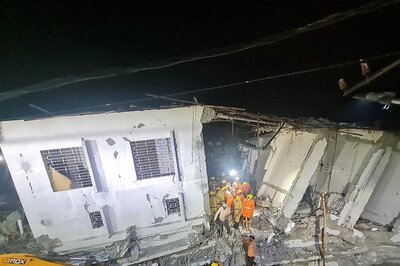
views
How to Repair a Leaking Garbage Disposal
Start by turning off the power. If your garbage disposal is plugged in, unplug it and turn off the power at the circuit breaker. If your garbage disposal is powered by a switch, flip the switch into the off-position and turn off the power at the circuit breaker. If your power is on while you work on your garbage disposal, you’ll risk electrocuting yourself. Double check that the garbage disposal and its wires aren’t electrified using a non-contact voltage tester.
If you have a dishwasher, disconnect the hose. Use a flathead screwdriver and untwist the bolt beneath the clamp on the hose to loosen the clamp. Once it’s loose, wiggle the hose off. Place a bucket underneath before you remove the hose to catch any water that leaks when you remove it.
Disconnect the P-trap. Twist the top ring of the P-trap (the curved pipe underneath the drain pipe) counterclockwise. Then, twist the lower ring counterclockwise to loosen the P-trap. Then, gently pull the trap to remove it. Keep a bucket underneath the P-trap to catch any water that leaks when you remove it. If you need more room, remove the drain hose from the P-trap by gently pulling it up.
Disconnect the ring and twist your garbage disposal off. Locate the metal ring with three insertable slots at the top of your disposal. Insert double-sided allen wrenches into two of them and turn counterclockwise to loosen the ring. Use one hand to hold the bottom of your disposal and the other to twist the ring away from the disposal. Then, gently remove your disposal. Be careful when disconnecting the ring, as your disposal can fall and damage you or the baseboard underneath the sink.
Remove the cover plate on the bottom. Turn your disposal on its side. Make sure the power is turned off, then turn the screw on the cover plate counterclockwise with a Phillips screwdriver. Remove the screw and open the plate.
Disconnect the wires. Unscrew the green bolt in the center to remove the ground wire. Use a screwdriver to pry out the inner wires. Twist the wire nuts off to disconnect the two sets of black and white wires, then remove the outer set of wires from the housing.
Unscrew the side bolts and remove the top. Use a screwdriver to unscrew the four bolts on the sides of the disposal. Remove them from the machine, then insert a flathead screwdriver into the gaps underneath where they were located. Use the flathead to raise the top of the fixture, then gently remove it.
Clean the inside of your disposal and inspect for holes. Use a wire brush to clean away any gunk or debris from your disposal. As you clean the disposal, keep your eye out for any holes that may have formed from rust or corrosion.
Use liquid weld epoxy to seal any holes. Squeeze the liquid weld epoxy into a bowl or cylindrical surface, then mix it together until it has a grey consistency. Coat the tip of an applicant, like a craft stick or paint brush, with the epoxy and apply it to the hole. Apply enough epoxy to cover the hole, then spread any excess around your disposal. Then, let it dry. Be careful not to apply too much epoxy to the sides, as it will be difficult to put the top of your disposal back on. If you do accidentally apply too much epoxy and it hardens, take a blade or similar metal object and chip it from your disposal.
Put the top back onto your disposal. Place the top of your disposal back on and align the four holes with those on the bottom part of the disposal. Re-insert the four side bolts and screw them in to secure the housing.
Reattach the disposal. Reattach your disposal at the mounting ring, insert a double-sided allen wrench or screwdriver into the two holes, and turn clockwise to tighten the disposal back into the ring.
Reattach your dishwasher hose. Connect the hose to the garbage disposal, then retighten the clamp by turning your flathead screwdriver clockwise.
Reattach your P-trap. Align the inserts of the P-trap with the inserts of the pipe and disposal, then insert the P-trap and tighten it by turning the rings clockwise.
Reattach your wires. Electrician James Hornof says remove the bottom cover, put a two-screw connector in for your cable, then bring the cable into the box where the switch is. Tighten the ground around the green bolt to ground the disposal. Bring two wire nuts together to attach your white wires together and your black wires together. Then inside of the switch, take the black wire to one of your switches, your whites are going to be made up together. Put the black wires into each terminal on your switch.
Reactivate the power and test your disposal. Turn the power back on at the circuit breaker, plug your disposal back in if it has a power cord, then run the water at your sink and turn your disposal on. Check underneath the sink for any leaks from the disposal. If everything’s dry, you’re good to go!
Why is your garbage disposal leaking?
Your seals may be worn or damaged. A worn or damaged seal is often the most likely culprit of a leaking garbage disposal. Although the seals are designed to keep water from leaking, they begin to degrade over time due to repeated use. As the seals degrade, your garbage disposal may become susceptible to leaking, especially if you’ve had it for a long time. If your seal has degraded, you need to replace it with a new one.
The housing may be cracked. Garbage disposals have tough interior shells that house all of the internal equipment, like wires and the motor. As your garbage disposal ages, the shell becomes vulnerable to cracking. When the shell cracks, water can seep through and cause leaking at the bottom of your disposal.
Your disposal may be rusting or corroding. As your disposal ages, it will show signs of that age through corrosion and rust, especially if you don’t use it. Corrosion and rust can gradually break down the structure of your disposal, leading to leaks. If your disposal is showing signs of significant rust or corrosion, you may have to replace it. Consult a plumber to decide what to do.
The connections may be disconnected or improperly installed. If the cords, pipes or wires of your garbage disposal were installed incorrectly, that may be the reason for your leak. For example, a dishwasher pipe that isn’t properly connected can lead to leaks underneath the sink.
The impeller may be damaged. Your impeller is a spinning object with sharp blades that is responsible for breaking down the food that you put into your dishwasher. The centrifugal force of the impeller attracts the food, while the blades break them down. If the impeller or its blades are damaged, your disposal may hum without starting. If so, contact a professional to repair them immediately.
How to Replace Your Leaking Garbage Disposal
Turn off the power. If your garbage disposal is powered by a power cord, unplug it and turn off the power at the circuit breaker. If your garbage disposal is powered by a switch, flip the switch into the off-position and turn off the power at the circuit breaker. Remember, having the power on while you work on your garbage disposal is a safety hazard.
If you have a dishwasher, disconnect the hose. Use a flathead screwdriver to untwist the bolt beneath the clamp on the hose. This will loosen the clamp. Once it’s loose, wiggle the hose off. Have a bucket underneath to catch any water leaks.
Disconnect the P-trap. Twist the top ring of the P-trap (the curved pipe underneath the drain pipe) counterclockwise. Then, twist the lower ring counterclockwise. This will loosen the P-trap. Once it’s loose, gently pull the trap to remove it. Keep a bucket underneath to catch any water leaks. For more room, remove the drain hose from the P-trap by gently pulling it up.
Disconnect the ring and remove your garbage disposal. Locate the metal ring with three insertable slots near the top of your disposal. Insert double-sided allen wrenches into two slots and turn counterclockwise to loosen the ring. Hold the bottom of your disposal with one hand and twist the ring loose with the other. Then, gently remove your disposal. Be careful when disconnecting the ring. Your disposal can fall and damage you or the sink’s baseboard.
If your flange is damaged, remove it from the sink insert and install a new one. Loosen the bolts holding the piece together with a flathead screwdriver. Insert a flathead screwdriver into the side gap in between your drain flange and disposal ring. Then, use the flathead to pop your drain flange out. Disassemble the new flange by using a flathead to unscrew the three bolts. Flatten out some plumber’s putty, place it around the edge of the flange, then firmly push the flange into the insert. Use a heavy object to hold your flange down.
Place the new ring into the underside of the flange. Reassemble the ring by placing the thin cardboard ring up top, and the lower ring with the bolt inserts underneath. Insert the new ring back into the flange and tighten the screws to secure it in place.
Remove the bottom cover plate. Turn your disposal on its side. Ensure that the power is turned off, then use a Phillips screwdriver to turn the screw on the cover plate counterclockwise. Remove the screw and open the plate.
Disconnect the wires. Remove the ground wire by unscrewing the green bolt in the center under the plate. Use a screwdriver to pry out the inner wires. Twist the wire nuts off to disconnect the two sets of black and white wires, then remove the outer set of wires from the housing.
If you have a dishwasher, remove the dishwasher plug. Take your new garbage disposal and insert a screwdriver into the upper hole where the dishwasher hose goes. Take a hammer and hit the back of the screwdriver to knock the dishwasher plug out. This will prevent water from backing up into your dishwasher. If you don’t have a dishwasher, leave this plug in.
Remove the wire plate and install the wires. Remove the wire plate on your new garbage disposal by using a Phillips screwdriver and turning the screw on the cover counterclockwise. Locate the white wires and pair them using a wire nut. Locate the black wires and do the same. Unscrew the green screw, wrap the ground wire around it, and screw it back to secure the wire. Push the wires back in, then reattach the plate.
Hang the disposal back up. Align the three open tabs with the mounting ring, then use the included allen wrench to turn the tabs clockwise and tighten them in place.
Reattach the hoses. Connect the dishwasher hose by aligning it with the hole on the garbage disposal, then retightening the clamp by inserting your flathead into the screw and turning it clockwise. Attach the P-trap to the drain hose by aligning the two holes together, then turning the rings clockwise to tighten them in place.
Reactivate the power. Plug your new garbage disposal back in if it’s powered by a power cord. Then, head to the circuit breaker and turn the power to your garbage disposal back on.
Test your new disposal. Turn on the water and power your garbage disposal back on. Check for any leaks or loose connections. If you don’t notice anything, you’re good to go!
How to Prevent Future Leaks
Use your garbage disposal regularly. It’s recommended to use your garbage disposal at least once every couple of days to keep the impeller blades from rusting. This rust can create holes and cause leaks. If you wait a long time to use your garbage disposal, it may simply hum without breaking any food down.
Run cold or warm water whenever you use your garbage disposal. Running cold or warm water will help move the food that’s breaking down from the disposal to the drain pipe. This can prevent any food build-up or waste from breaking down the inners of your garbage disposal and causing leaks.
Frequently Asked Questions
What if your garbage disposal is leaking from the reset button? If your garbage disposal is leaking from the reset button, the inside is likely rusted through. If this is the case, you will have to get a new disposal. Once the inside rusts through, water begins to interact with the wires in the housing, which is extremely dangerous.
Will my garbage disposal break down hard objects, like bones and eggshells? No. In fact, your garbage disposal may have a hard time with breaking down tough objects. Putting hard objects into your garbage disposal can even damage your blades. Handyman Jacob Pischer says that garbage disposals usually jam because of orange peels, apple peels, bones, or other things getting stuck between the disposal’s teeth and sidewall, which stops the motor from turning.
How can I sharpen the blades of my garbage disposal? Insert ice cubes into the disposal, start it and let the water run, and let it break them down.
How can I get rid of an odor in my garbage disposal? Take oranges or lemons, chop them up or use their peels, and insert them into the disposal. Run some cold water into the disposal, then start it. This will break down the object causing the odor and replace it with a citrusy smell.




















Comments
0 comment